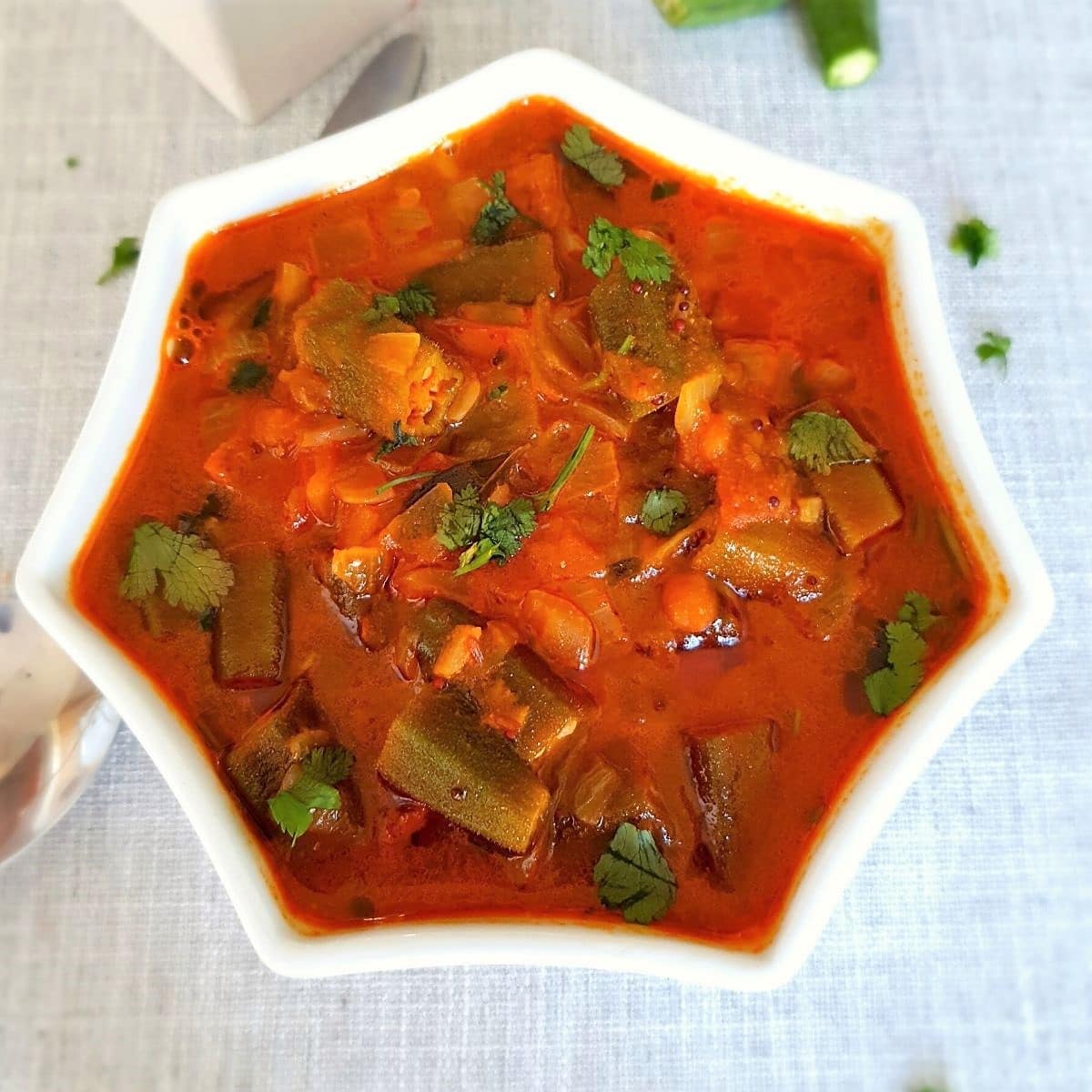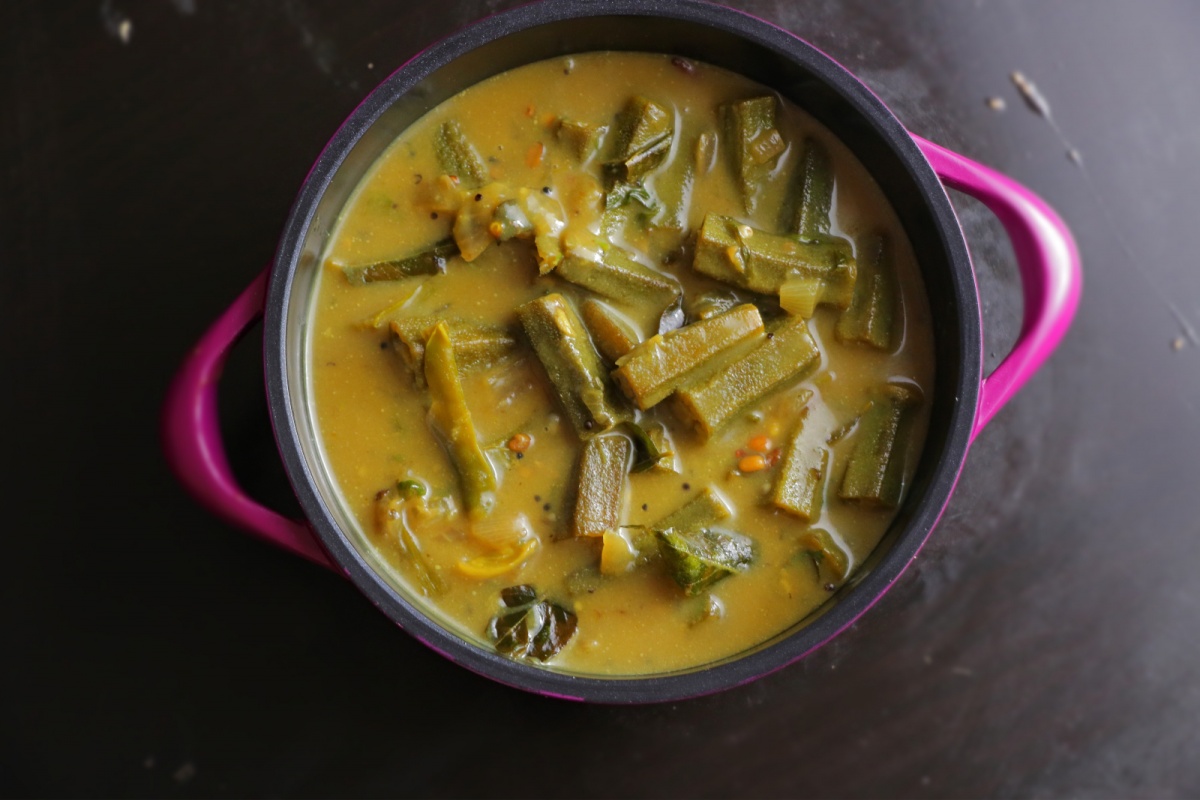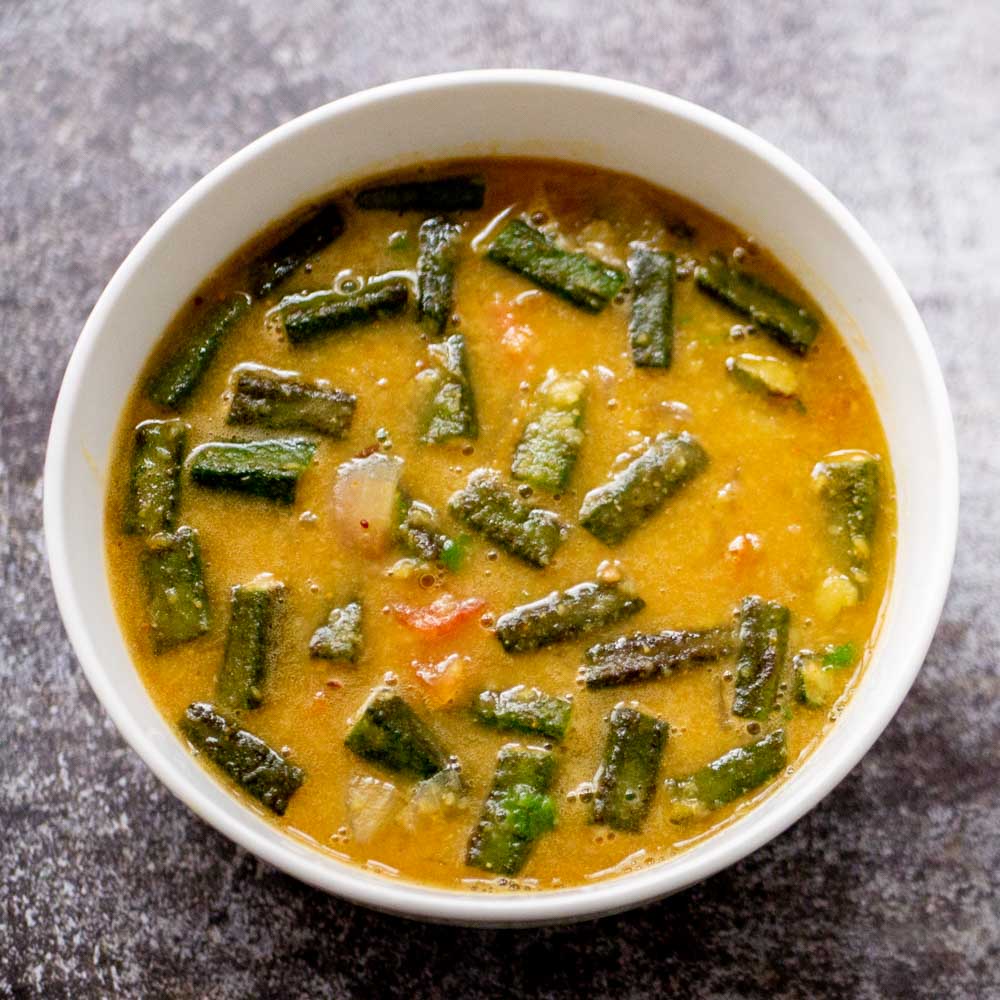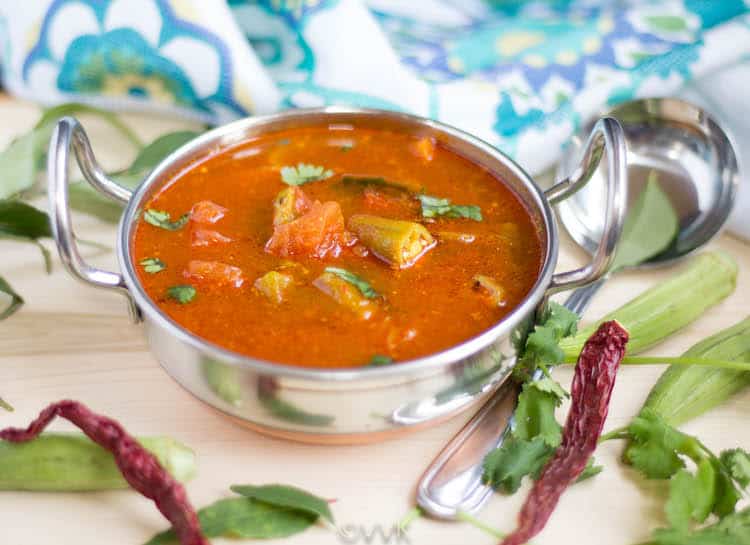Bendakaya Ullipaya Pulusu is a comforting and tangy stew that is a staple in many homes across the southern states of India, particularly in Andhra Pradesh and Telangana. This traditional dish is celebrated for its delightful combination of flavors and textures, which come together to create a truly satisfying meal.
At the heart of this dish is the bendakaya, or okra, known for its unique texture and ability to absorb the rich flavors of the pulusu, or stew. The ullipaya, or onions, contribute a natural sweetness and body to the dish, complementing the succulent okra pieces. These vegetables are simmered gently in a tamarind-based sauce, which imparts a characteristic sour note that is fundamental to the dish’s flavor profile.
The pulusu is seasoned with a variety of aromatic spices, such as mustard seeds, cumin, fenugreek seeds, and curry leaves that are tempered in oil, releasing their fragrant oils and infusing the stew with warmth and depth. Red chili powder adds a subtle heat to the stew, while turmeric brings its earthy tones and vibrant color. The use of jaggery or sugar helps to balance the tanginess of the tamarind, rounding out the flavors beautifully.
Bendakaya Ullipaya Pulusu Recipe


Bendakaya Ullipaya Pulusu
Equipment
- 1 large skillet
Ingredients
- 2 tablespoons vegetable or corn oil
- 1 teaspoon mustard seeds
- 1 teaspoon fenugreek seeds
- 1/2 teaspoon asafoetida
- 1 green chile slit lengthwise
- 2 curry leaf sprigs
- 10 shallots peeled
- 11/2 teaspoons ginger-garlic paste
- 3 okra cut crosswise into 2-inch slices
- 1 tomato finely chopped
- 11/2 teaspoons salt
- 2 teaspoons red chile powder
- 11/2 tablespoons tamarind paste
- 21/2 cups water divided
- 1 teaspoon rice flour optional
Instructions
- In a large skillet or wok over medium heat, heat the oil.
- Add the mustard seeds, fenugreek seeds, and asafoetida. Cook until the mustard seeds begin to sputter, about 1 minute.
- Add the green chile and the curry leaves. Cook for 30 seconds.
- Add the shallots and ginger-garlic paste and cook for 3 to 4 minutes, until the shallots no longer smell raw.
- Add the okra and cook for 3 minutes more.
- Stir in the tomato, salt, and chile powder. Sauté for 5 minutes, until the tomato is soft and broken down.
- Add the tamarind paste and 2 cups of water and stir until mixed well. Reduce the heat to medium-low and simmer for 15 minutes.
- If you prefer a thinner gravy, skip this step. For a thicker gravy, in a small bowl, whisk the rice flour and remaining 1⁄2 cup of water. Stir this paste into the pulusu and simmer for 5 minutes. Turn off the heat.
Notes
Cooking Tips about Bendakaya Ullipaya Pulusu

- Selecting Quality Ingredients: Use fresh okra and onions as they are the key components of the dish. Fresh okra should be bright green and free from blemishes.
- Cutting Technique: Slice the okra into bite-sized pieces and the onions lengthwise to ensure they cook evenly and absorb the flavors of the tamarind sauce well.
- Prevent Okra Sliminess: To minimize sliminess, dry the okra thoroughly after washing and before cutting. Optionally, you can also lightly fry the okra before adding it to the stew.
- Tamarind Preparation: Soak the tamarind in warm water and extract its juice by mashing and straining it. The sour tamarind juice is essential for the distinct tangy taste of the pulusu.
- Balancing Sourness: Adjust the amount of tamarind to your preferred level of sourness, and balance it with a touch of jaggery or sugar to round out the flavor.
- Correct Spice Temper: Heat oil in a pan and add the tempering spices such as mustard seeds, cumin, fenugreek seeds, and curry leaves until they splutter and release their aromas. This foundational step adds depth to the dish.
- Thicken the Stew: Simmer the stew until the vegetables are tender and the stew thickens slightly. If the pulusu is too thin, you can mash a few pieces of okra to help thicken it.
- Gentle Cooking: Cook the mixture on a low to medium heat to prevent the vegetables from becoming mushy and to allow the flavors to develop fully.
- Adjust Seasoning: Taste the pulusu and adjust the salt, spiciness, and sourness according to your preference. Each component should be balanced.
- Finish with Fresh Herbs: Garnish with fresh coriander for an added burst of flavor just before serving.
Serving suggestions about Bendakaya Ullipaya Pulusu

- With Steamed Rice: This dish is traditionally served with steamed rice, allowing the grains to soak up the flavorful tamarind sauce.
- Indian Flatbreads: It also pairs wonderfully with different Indian flatbreads such as chapati, roti, or paratha for a fulfilling bite.
- As Part of a Thali: Include Bendakaya Ullipaya Pulusu as an integral component of a South Indian thali, surrounded by other regional specialties like dal, yogurt, and rice.
- Accompany With Papad: Complement it with crispy papads on the side for added texture and flavor contrast.
- Garnish With Fresh Herbs: Enhance the dish just before serving with a sprinkle of fresh coriander leaves for an extra burst of aroma and color.
- Cooling Yogurt Side: Offer a side of cooling yogurt or cucumber raita to balance out the tanginess and heat from the pulusu.
- Include in a Buffet Spread: If hosting, add Bendakaya Ullipaya Pulusu to a buffet spread, letting guests enjoy a variety of dishes.
- Hot Pickles: Serve with a side of hot Indian pickles which can elevate the tasting experience by adding a spicy kick.
Top 5 FAQs about Bendakaya Ullipaya Pulusu

- What is Bendakaya Ullipaya Pulusu and how does it taste? Bendakaya Ullipaya Pulusu is a tangy and comforting stew from the southern states of India, particularly Andhra Pradesh and Telangana. It consists of okra (bendakaya) and onions (ullipaya) cooked in a tamarind-based sauce with traditional spices. The dish has a unique balance of sour, sweet, and spicy flavors, with the vegetables absorbing the rich seasoning to create a hearty and satisfying meal.
- Can Bendakaya Ullipaya Pulusu be made without tamarind for a less tangy taste? While tamarind is a key ingredient providing the characteristic tanginess, you could reduce its quantity or substitute it with a milder acid like tomatoes or lemon juice for a less tangy version. However, doing so will alter the authentic flavor of the dish.
- What is the best way to prevent sliminess in the okra when making this dish? To minimize the sliminess, ensure that the okra is dried thoroughly after washing. Frying the okra lightly before adding it to the stew can also help. Moreover, avoid covering the pan while cooking the okra, as trapped steam can increase sliminess.
- How do I adjust the consistency of the Pulusu if it’s too thin or too thick? If the pulusu is too thin, simmer it for a longer period to reduce and thicken, or mash some of the okra pieces to naturally thicken the sauce. If it’s too thick, simply add a bit of water until you reach your desired consistency.
- What are some common techniques for tempering spices for Bendakaya Ullipaya Pulusu? Temper the spices by heating oil in a pan and then adding mustard seeds, cumin, fenugreek seeds, and curry leaves. Wait until the spices begin to crackle and release their aromatic oils, which will infuse the stew with warmth and depth of flavor. Be careful not to burn the spices, as this can impart a bitter taste.

Leave a Reply